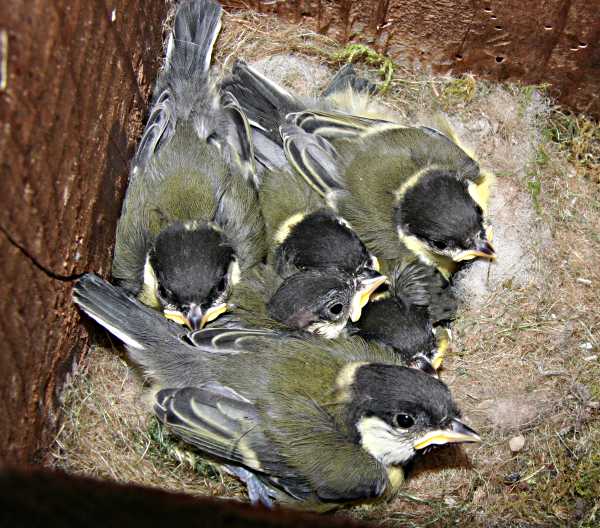捕食者的警戒色教室:天真的大山雀如何學習辨認警戒性的半翅類?
 |
| 大山雀 (Great tit, Parus major) (wiki) |
標題:How do predators learn to recognize a mimetic complex: Experiments with naive great tits and aposematic heteroptera.
摘要
We tested the importance of innate wariness, avoidance learning, memory and generalization for the formation of predatory behaviour in naive great tits (Parus major) towards mimetic complex of four aposematic species of true bugs (Insecta: Hemiptera: Heteroptera): Lygaeus equestris, Spilostethus saxatilis, Pyrrhocoris apterus and Graphosoma lineatum. The birds showed almost no innate wariness against the aposematically coloured bugs, although a hidden wariness elicited by defensive chemicals of some of the bug species is not excluded. Naive birds learned to avoid different species at different rates, which resulted in different prey mortalities. The avoidance learning was faster when the defensive chemicals produced an immediate irritating effect (particularly when squirted into distance – G. lineatum) than when they caused sickness several minutes after the consumption (P. apterus). The experience of birds from learning to avoid a particular species of bug affected their subsequent behaviour to other species – experience with better-defended species resulted in longer attack latencies, more cautious attacks, broader generalization and lower prey mortality. The least defended species, P. apterus, benefited from the experience of birds with better-defended species, whereas the birds’ experience with P. apterus did not reduce mortality risk of the other species comparably. Judging from the inexperienced young birds, the mimetic relation- ships are likely to be quasi-Batesian. However, as wild-caught great tits avoid all the four species to the same extent, the relationships may become more mutualistic (quasi-Müllerian) in later phases of learning under natural conditions. The relationships among species in the mimetic complex thus seem to depend on the amount of experience of the bird predators.
雖然很多討論擬態的文章以行為學的實驗來驗證假設,最常使用的是大山雀、藍山雀與家雞,除了好生好養好抓,對這種鳥的習性瞭解,更重要的行為學家認為這可以代表鳥類的捕食者。但有意思的是,雖然做過這麼多實驗,真的討論這些鳥種的基礎認知行為的證據似乎都很間接,通常是某個實驗做完後順便討論一下「這個鳥似乎天生有點怕某個東西」,因此雖然做了這麼多實驗,仍有許多的現象與理論發生衝突,有沒有可能因為對於我們所使用的鳥種還不夠瞭解?
 |
| 大山雀亞成鳥 photo: Clarke Brunt |
作者群因此想知道捕食者的辨識警戒性/擬態的重要認知因子的基礎能力,像是天然呆(X),天生的警覺性(O),避免再次吃到難吃獵物的學習力,記憶力,與概括認知能力等,最常採用討論相關理論的大山雀 (Parus major) 自然就是討論的目標首選。作者群讓完全沒有經驗,天真無邪的大山雀攻擊四種椿象:Lygaeus equuestris, Spilostethus saxatilis, Pyrrhocoris apterus, Graphosoma lineatum。這類的椿象大多具有紅黑條紋,體內有防禦機制,有些種類被攻擊時還會放出臭氣讓捕食者避忌。就這四種椿象來說的話,其防禦的程度P. apterus的臭氣是最低的。作者群25隻手養的大山雀,飼養過程中符合動物福利原則,在飼養的過程中餵食麵包蟲、家蟋蟀、食蟲鳥類綜合飼料、綠色與褐色的昆蟲(野外抓)、水煮蛋與維他命,確保幼鳥能取得多類型的營養平安又健康的長大,又不會被飼養中某些特殊顏色影響學習經驗。等到這些鳥長大到40-60天時,就開始進行實驗。實驗進行主要分為兩個部分:第一天是「避忌學習」(avoidance learning),第二天是「概括學習」(generalization)。避免學習的實驗讓鳥試著學習避免上述四種椿象之一,然後在概括學習中同時呈現四種椿象。
 |
| Fig. 1 實驗中討論的四種椿象,與其在系統發生學上的特徵與相對親緣關係。 |
結果顯示這些鳥幾乎對這些警戒色沒有任何天生的警覺性(天然呆?),但對某些防禦性化學物質有警覺。這些天真的鳥對不同椿象的學習速度都不一樣。在「避忌學習」的結果中,會放出防禦性化學物的物種G. lineatum,能讓鳥學的比咬下去才知道難吃的學的快(P. apterus)。這些鳥基於學到的經驗,對於接下來的行為產生改變:有很難吃經驗的個體,在面對類似的警戒色時,攻擊延遲時間會比較長,更多謹慎的攻擊,讓這些獵物的死亡率較低。而這些椿象中防禦性最低的P. apterus,受惠於那些有過很難吃經驗的個體,反之,若鳥沒經歷過那些很難吃的,P. apterus的死亡率沒有顯著的降低。綜合以上的結果來看,這些椿象看起來像是準貝氏擬態(quasi-Batesian mimicry)的關係,但從野外抓回來的鳥的實驗來看,對於四種椿象都有避忌行為,因此作者群認為大山雀在野外學習到最後,會讓椿象的關係比較接近準穆氏擬態(quasi-Müllerian mimicry)。
這個實驗結果部分的揭開大山雀這個實驗物種的學習經歷,與這對警戒性/擬態物種的影響,但仍有些問題存在。像是其實我們對於鳥類的大腦發育與學習不如人類瞭解,手養鳥雖然可以避免某些額外的因子,但有沒有可能在飼養的過程中大腦的發育與認知就已經被限制,許多的飼養觀察也指出,手養鳥與野生鳥的行為差異極大,前兩年也有篇Nature的文章指出,實驗室飼養的果蠅比起野外的果蠅行為單一許多。這讓我們不得不考慮用手養鳥究竟是不是能解釋實驗動物的天生行為,但如果不手養,又有沒有什麼辦法測試這些內在因素?
而這樣的試驗是否又告訴我們,未來若要採用新的實驗動物前,必須要先瞭解動物的「內心」,才能進行進一步的試驗?





0 comments